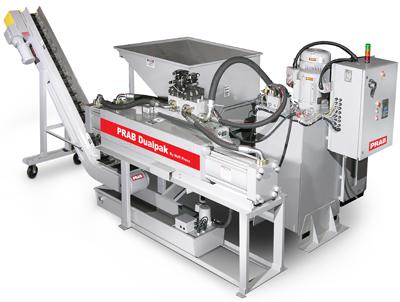
PRAB's Dualpak briquetter adds value to scrap, reduces volumes and transportation costs, and helps manufacturers comply with EPA regulations by removing hazardous cutting fluid from material. Plus, helps recapture coolant and lubricant. Augers feed the wet chips or swarf into a compression chamber where opposing hydraulic cylinders press the metal and squeeze out any fluid to create a compact, dry briquette.
"The briquettes created by Dualpak's exclusive dual-compaction are easy to remelt and can bring a better price from recyclers because they know that 99 percent of the weight is the actual metal, not fluid," said Mike Hill, vice president of PRAB sales and marketing. "Plus, briquettes are easy to store, helping to maintain a cleaner shop floor and making it convenient to hold on to them and sell when metal prices are high."
The Dualpak is easy to operate, featuring touch screen controls for access to reporting and diagnostics, and can process aluminum, steel, cast iron, copper, brass, titanium, magnesium, Inconel, alloy steels, and more. As part of a scrap recycling and fluid reclamation system, combine Dualpak with PRAB's wringers, crushers, conveyors, and liquid-solid and liquid-liquid filtration.
Contact Details
Related Glossary Terms
- alloy steels
alloy steels
Steel containing specified quantities of alloying elements (other than carbon and the commonly accepted amounts of manganese, sulfur and phosphorus) added to cause changes in the metal’s mechanical and/or physical properties. Principal alloying elements are nickel, chromium, molybdenum and silicon. Some grades of alloy steels contain one or more of these elements: vanadium, boron, lead and copper.
- coolant
coolant
Fluid that reduces temperature buildup at the tool/workpiece interface during machining. Normally takes the form of a liquid such as soluble or chemical mixtures (semisynthetic, synthetic) but can be pressurized air or other gas. Because of water’s ability to absorb great quantities of heat, it is widely used as a coolant and vehicle for various cutting compounds, with the water-to-compound ratio varying with the machining task. See cutting fluid; semisynthetic cutting fluid; soluble-oil cutting fluid; synthetic cutting fluid.
- cutting fluid
cutting fluid
Liquid used to improve workpiece machinability, enhance tool life, flush out chips and machining debris, and cool the workpiece and tool. Three basic types are: straight oils; soluble oils, which emulsify in water; and synthetic fluids, which are water-based chemical solutions having no oil. See coolant; semisynthetic cutting fluid; soluble-oil cutting fluid; synthetic cutting fluid.
- feed
feed
Rate of change of position of the tool as a whole, relative to the workpiece while cutting.
- swarf
swarf
Metal fines and grinding wheel particles generated during grinding.

